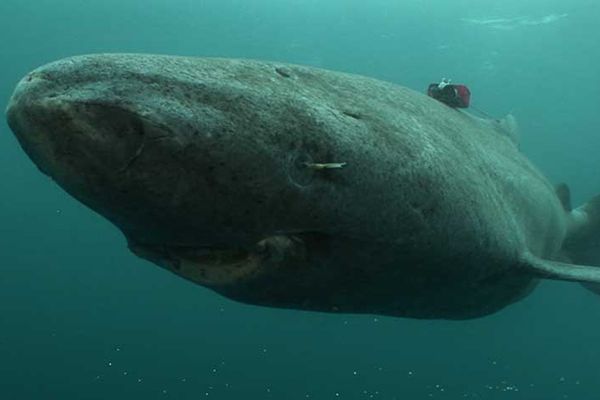
Presenting the World's Slowest Shark

Greenland sharks are the slowest known sharks, according to a new study that found these sharks move through the water at only about a mile per hour.
The study, which will be published in the September issue of the Journal of Experimental Marine Biology and Ecology, also finds that the sharks are the slowest known fish, when body size is factored in. Greenland sharks just reach top speeds of about 1.7 miles per hour.
"We think that the slow speed of Greenland sharks might be due to low water temperature in the Arctic Ocean," lead author Yuuki Watanabe of the National Institute of Polar Research told Discovery News.
Watanabe and his colleagues used data logging tags to measure the swim speed and tail beat frequency of six free-swimming Greenland sharks. The measurements were then compared to previously recorded data concerning other sharks and fish. (Sharks are considered to be a type of fish.) The mean tail beat frequency for Greenland sharks topped off at 9 beat cycles per minute.
NEWS: Shark Teeth Have Built-In Toothpaste
Both this tail beat frequency and the maximum recorded speed for Greenland sharks were the lowest values, when size is considered, across all other known measurements for fish species. Since tail beats reflect muscle-shortening speed, which in turn has been tied to decreasing temperature, the researchers suspect the cold environment of Greenland sharks has turned them into slowpokes.
"Many physiological processes, including muscle shortening speed, slow down with decreasing temperature," Watanabe explained. "This is called the Q10 effect, and it's very strong. Humans do not feel this, because our body temperature is kept high even at cold temperatures. In the case of fishes, body temperature decreases with decreasing ambient temperature, and many physiological processes are depressed."
Sign up for the Live Science daily newsletter now
Get the world’s most fascinating discoveries delivered straight to your inbox.
The slowness of the sharks puts a different twist on the usual marine predator-prey scenario. Many aggressive shark predators zip quickly through the water, enabling them to overtake slower-moving fish and sea mammals.
SHARK WEEK: Don’t Miss the 25th Anniversary of Shark Week
When the stomach contents of Greenland sharks have been analyzed in the past, scientists have found a lot of fish, but also fresh seals that weren't just scavenged.
"How Greenland sharks hunt seals remains a mystery," Watanabe said. "We hypothesize that sharks hunt seals sleeping in the water because of two reasons. First, seals in captivity can sleep in the water -- at the surface or on the bottom."
"Second," he added, "although how seals sleep in the wild is not known, we in the field observed a seal floating at the surface. At first we thought it was a dead seal, and approached it by boat and actually touched it. Then the seal suddenly started moving and dove down."
There's a good chance, then, that the slow-moving Greenland sharks are simply able to approach a snoozing seal and enjoy a relatively easy dinner.
As for the Greenland shark's own predators, they don't have many because of their very large body size. Some individuals can grow to become 21 feet long, weighing 2,200 pounds. Killer whales might be able to eat them, Watanabe suspects, but Greenland sharks usually stay within deep water that killer whales do not frequent.
Yannis Papastamatiou, a research biologist in the Florida Museum of Natural History's ichthyology department, said that "data loggers are really allowing us to get a much greater understanding of what animals are doing in the wild. The high resolution swim speed sensors provide some of the most accurate data available on the swim speeds of marine animals."
He concluded, "There was evidence that Greenland sharks were slow swimmers, but this study really proved just how slow they were!"
This story was provided by Discovery News.












